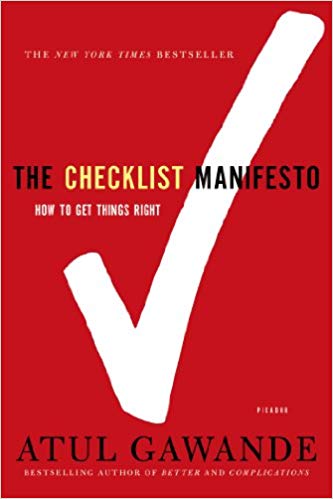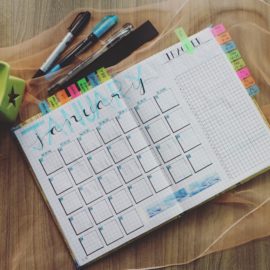

This article is an excerpt from the Shortform summary of "The Checklist Manifesto" by Atul Gawande. Shortform has the world's best summaries of books you should be reading.
Like this article? Sign up for a free trial here .
We all make mistakes, but sometimes we look back and see that we could have easily prevented some of our errors. Do you ever wonder how to avoid mistakes that seem obvious in hindsight?
To avoid mistakes at work and during your everyday tasks, use a checklist. We’ll cover how checklists prevent failure, how to create effective checklists, and why they’re necessary in today’s complex world.
How to Avoid Mistakes
In complex environments, checklists can help to avoid mistakes by addressing two problems:
1) Our memory and our attention to detail fail when we’re distracted by more urgent matters. For instance, if you’re a nurse, you might forget to take a patient’s pulse when she’s throwing up, a family member is asking questions, and you’re being paged.
Forgetfulness and distraction are especially risky in what engineers call all-or-none processes, where if you miss one key thing, you fail at the task. For instance, if you go to the store to buy ingredients for a cake and forget to buy eggs, you can’t make the recipe because it wouldn’t work without eggs. The consequences are more serious if a pilot misses a step during take-off or a doctor misses the key symptom. Checklists can help us avoid mistakes like these.
2) People have a tendency to skip steps even when they remember them. In complex processes, certain steps don’t always matter, so people may play the odds and skip them. For instance, if measuring all four of a patient’s vital signs (pulse, blood pressure, temperature, and respiration) only rarely detects a problem, you might become lax about checking everything.
Checklists protect against such failures and help you avoid mistakes because they remind you of the minimum necessary steps by spelling them out. They allow you to verify each step while also establishing and instilling a performance standard. This is how to avoid mistakes.
Make an Effective Checklist
While it should be simple to use, developing an effective checklist isn’t a simple task. It requires analysis, real-world testing, and revision. However, it’s key to avoiding mistakes.
Daniel Boorman, flight desk designer for Boeing, is an expert at developing checklists. He’s analyzed thousands of crashes and mishaps in an effort to figure out how to create checklists that prevent human errors and help you avoid mistakes.
Boorman’s checklists for Boeing aircraft fill a thick spiral-bound handbook with tabs. Yet each checklist is brief, consisting of a few lines on a page in large, easy-to-read type. Each applies to a different situation; together they encompass a range of scenarios. At the beginning of the notebook are what pilots call “normal” checklists for routine operations — for instance, steps to take before starting the engines. They’re followed by “non-normal” checklists for emergency situations such as engine failure, smoke in the cockpit, or an insecure door. These tell pilots how to avoid mistakes.
Over two decades, Boorman has learned how to make checklists that work. There are key differences between bad and good checklists.
Bad checklists are:
- Unclear and imprecise.
- Too long, impractical, and difficult to use.
- Created by pencil pushers who lack experience doing what their checklists dictate.
- Overly detailed. They try to spell out every single step, as if the users are clueless.
- Mind-numbing, rather than engaging.
Good checklists:
- Are precise, efficient, concise, practical, and easy to use even in the most difficult circumstances.
- Don’t try to spell out everything. They provide reminders of only the most important steps that even an experienced professional could miss.
How to avoid mistakes? Your checklists need to be concise and practical, or you won’t use them.
How to Create a Checklist
(Shortform note: also see “A Checklist for Checklists.”)
Before creating a checklist, decide two things. These are key to figuring out how to avoid mistakes:
1) Define a clear ‘“pause point” at which the checklist is to be used (unless the moment is obvious, such as when something malfunctions).
2) Decide whether to create a Do-Confirm list or a Read-Do list.
To use a Do-Confirm checklist, team members perform their jobs from memory. Then they stop and go through the checklist and confirm that they completed every item on the checklist. In contrast, to use a Read-Do checklist, people carry out each task as they check it off, like a recipe.
(Shortform note: Choose the type of checklist that makes the most sense for the situation. For instance, a Read-Do list could be used when the sequence needs to be exact or the entire effort will fail, like in operating machinery or listing emergency tasks. A Do-Confirm list gives more freedom and is allowable when the stakes are lower, and a forgotten step can be done later out of sequence. Choosing the right type will help you avoid mistakes.)
Once you’ve chosen which type of checklist you’re creating, follow these guidelines:
- Keep the checklist short, typically five to nine items, which is the limit of short-term memory. After 60 to 90 seconds, a checklist becomes a distraction from other things. People are likely to skip or miss steps.
- Focus on the “killer” items or steps that are most dangerous to miss but that are still sometimes overlooked.
- Remember that checklists are not supposed to be how-to guides. They are quick, simple tools to aid the recall of experts.
- Keep wording simple and exact.
- Use language and terminology familiar to the user.
- Fit the checklist on one page.
- Avoid clutter and unnecessary or distracting colors.
- Use upper and lowercase text in a sans serif font for ease of reading.
Test your checklist in the real world — have people use it and provide feedback. Boorman tests his checklists in a flight simulator. Language that you think is clear may not be to someone else. In practice, things are always more complicated than anticipated. Keep revisiting and testing the checklist until it works consistently. This is how to avoid mistakes.
Why Do We Make Mistakes?
The successful experiences of using checklists in aviation decades ago suggest they could be applied widely. They help the most experienced avoid mistakes in a whole range of tasks. They provide a mental safety net against typical human lapses in memory, focus, and attention to detail.
Professors Brenda Zimmerman and Sholom Glouberman, who study complexity, defined three kinds of problems: simple, complicated, and complex.
- Simple: An example of a simple problem is baking a cake from a mix — there’s a recipe and a few techniques, but once you’ve learned them, following the recipe usually works.
- Complicated: An example of a complicated problem is sending a rocket to the moon. Complicated problems can be broken down into smaller problems. Solving the problem involves many people, teams, and specialists. Unexpected issues pop up, but you can learn, repeat the process, and perfect it. Timing and coordination are key.
- Complex: An example of a complex problem is raising a child. Every child is unique. You learn from raising one child, but the next child may require a different approach. With complex problems like raising a child, the outcome is uncertain. Yet it’s possible to raise a child successfully.
In classifying the three problems described so far in this book — the bomber crash of 1935, the issue of central line infections, and the rescue of a drowning victim — the key problem and solution in each case were simple:
- To avoid crashing the bomber, focus on the rudder and elevator controls.
- To reduce central line infections, maintain sterility.
- To saving a drowning victim, be ready to perform a cardiac bypass
All could be resolved by using a simple tool to compel the needed behavior — a checklist. We’re constantly confronted with similar simple problems that can be mitigated by checklists — for instance, a nurse’s failure to wear a mask while putting in a central line or a surgeon’s failure to recall that one cause of a cardiac arrest could be a potassium overdose.
But can checklists be used to address complicated or complex problems, such as ICU work, where there are many tasks performed by multiple people, dealing with individual patients with individual and complex problems? Medicine encompasses all three types of problems — simple, complicated, and complex. It’s important to get basic things right, while allowing skill, judgment, and ability to react to the unexpected. No matter the context, checklists can help you avoid mistakes.
The medical profession could learn from the construction industry, which handles the design and construction of huge and complicated structures with the help of sophisticated checklists addressing the full range of problems.
———End of Preview———

Like what you just read? Read the rest of the world's best summary of "The Checklist Manifesto" at Shortform . Learn the book's critical concepts in 20 minutes or less .
Here's what you'll find in our full The Checklist Manifesto summary :
- How checklists save millions of lives in healthcare and flights
- The two types of checklists that matter
- How to create your own revolutionary checklist






